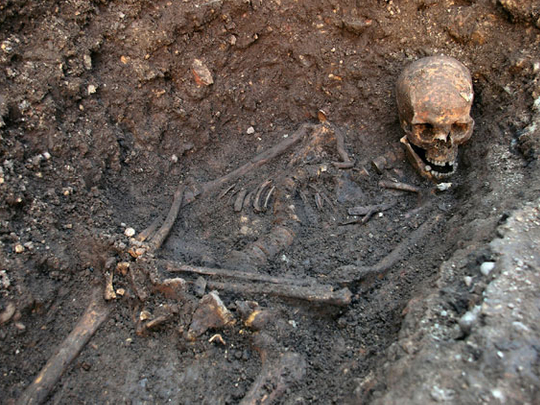
Leicester: British researchers said on Monday that a skeleton with a cleaved skull and a curved spine entombed under a car park was that of Richard III, solving a 500-year-old mystery about the final resting place of the last English king to die in battle.
Richard, depicted by William Shakespeare as a monstrous tyrant who murdered two princes in the Tower of London, was killed fighting his eventual successor Henry Tudor at the Battle of Bosworth Field in central England in 1485.
A team of archaeologists and historians from the University of Leicester said evidence showed that a skeleton found last year during excavations of a medieval friary under a parking lot in the city was indeed that of Richard.
After a detailed academic presentation detailing the life and wounds of Richard III, the lead archaeologist on the project, Richard Buckley, announced his conclusion to cheers and applause.
“It’s the academic conclusion of the University of Leicester that beyond reasonable doubt the individual exhumed at Greyfriars in September 2012 is indeed Richard III, the last Plantagenet king of England,” Buckley said.
Academics said DNA taken from the body matched that of Michael Ibsen, a Canadian-born furniture maker in London who genealogists said was the direct descendant of Richard’s sister, Anne of York.
The skeleton showed signs of injuries consistent with wounds received in battle; a bladed implement appeared to have cleaved part of the rear of the skull while a barbed metal arrowhead was found between vertebrae of the skeleton’s upper back.
While the findings may solve one riddle about Richard, the last Plantagenet king of England remains a complex figure whose life, made famous by Shakespeare’s history play, deeply divides opinion among historians in Britain and abroad.
Richard III remains an enigma — villain to many, hero to some. He ruled England between 1483 and 1485, during the decades-long tussle over the throne known as the Wars of the Roses. His brief reign saw liberal reforms, including introduction of the right to bail and the lifting of restrictions on books and printing presses.
His rule was challenged, and he was defeated and killed at the Battle of Bosworth Field by the army of Henry Tudor, who took the throne as King Henry VII.
For centuries, the location of Richard’s body has been unknown. Records say he was buried by the Franciscan monks of Grey Friars at their church in Leicester, 160 kilometres north of London. The church was closed and dismantled after King Henry VIII dissolved the monasteries in 1538, and its location eventually was forgotten.
Then, last September, archaeologists searching for Richard dug up the skeleton of an adult male who appeared to have died in battle. There were signs of trauma to the skull, perhaps from a bladed instrument, and a barbed metal arrowhead was found between vertebrae of the upper back.
The remains also displayed signs of scoliosis, which is a form of spinal curvature, consistent with contemporary accounts of Richard’s appearance, though not with Shakespeare’s description of him as “deform’d, unfinished,” hunchback.
The university has said the findings amount to “strong circumstantial evidence” that the remains are Richard’s. Ahead of Monday’s revelation of the results, the University of Leicester released an image of the body’s skull. Archaeologist Jo Appleby said it was found “in good condition, although fragile,” and had yielded detailed information about the individual.












